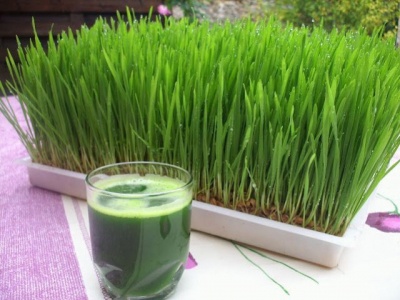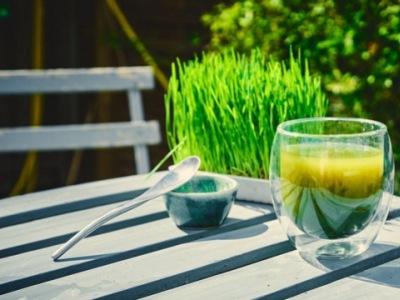Before to be able to make barley grass juice, here is the method to sprout different seeds.
Then to make juices, you will have to grow the shoots, and finally you can extract the juice.
All these steps are described below.
1°) Instructions for sprouted seeds in general.
Seeds germination in general including barley seeds.
We use:
• either ready-to-use sprouters, sold in shops (of 2 levels and more);
• a white glass jar (e.g., can or jam salvage pot). In addition, you will need:
• a mosquito net and one elastic per bottle, which will serve as a lid through which the air can penetrate;
• new and in good condition organic seeds;
• preferably filtered drinking water or source water in glass bottle.
The cold slowing down the germination process, you have to choose, in winter, a room warm enough (such as the kitchen).
We can find in shops very efficient electric sprouters, to keep an ideal constant temperature.
Advice:
For beginners, it is advisable to start with small quantities: 1 to 2 tablespoons, for example.
The different stages of germination to follow:
• pour in the jar the required amount of seeds and soak in the water for about 12 hours (preferably use filtered or source water).
Seeds must be fully immersed in a good volume of water. If they are not very clean, they can be washed with water before soaking them. For small seeds (such as alfalfa, sesame, unpeeled sunflower), the soaking time can be reduced from 1 to 5 hours.
• during the first phase of soaking, the jar will be upright.
• After this period of soaking, rinse the seeds, 1-2 times a day, with cold filtered water in summer and warm water in winter.
• for the second phase, the jar will be placed horizontally or slightly leaning over in diagonal at about 30° so that the seeds can "breathe" and not be piled on each other.
• do not put too many seeds, to promote good oxygenation.
• the place chosen to realize your growing must be ventilated, but without too strong exposure to sunlight.
• after a few days of germination, the seeds will be ready for consumption.
• for wheat and cereals, the germ may be between 1 to 3 mm in length.
• small seeds (radish, cabbage, etc.) can be consumed until the sprout reaches 2 or 3 cm.
• for sunflower, alfalfa and soy bean, sprouts can reach 6 to 7 cm. Never consume soy bean seed itself, only the shoot.
• do not germinate nightshade seeds (such as potato, eggplant, tomato, pepper).
2°) Consumption of sprouted seeds
Sprouted seeds are consummed:
• alone (from 1 to 3 tablespoons in the morning or noon preferably);
• in combination with crudités;
• in combination with oleaginous fruit (but not with watery fruit);
• either by incorporating them into a soup;
• either in combination with cereals (sprouted legumes and pasta or rice, for example);
• either with rice or other cereal cakes;
• or in the form of sprouted seeds crushed and incorporated in biscuits; etc.
Sprouted seeds in shoots
While the sprouted seed is consumed in sprouts of about 0.5 cm for cereals, it is eaten in shoots of 1 to 5 cm for legumes and vegetables.
3°) Instructions for young shoots.
• soak the seeds for about 12 hours in a jar filled with water.
• get a plastic box or tray (with a watertight bottom if you live in an apartment) and place about 1 to 2 cm of untreated countryside or garden soil.
• moisturize the soil with good quality water, then sow the seeds without breaking them.
• cover the box with another tray or dark plastic to keep the seeds away from light and moisture.
• check the degree of humidity, especially in summer, using if necessary a water spray that you will use in the morning and evening.
• as soon as the root appears after a few days, remove the lid.
• let the light penetrate, but do not expose the young shoots to the bright sun.
• ideal temperature is between 20 to 25°C.
• the consumption of the shoots can be after a period of 7 to 14 days, depending on the seed species and the ambient temperature conditions.
• young shoots can be consumed together with crudités, sprouted seeds or salads, etc.
Wheat or barley juices.
Wheat or barley juices are an extraordinary way to revitalize ourselves. The high-level sportswoman, Karine Herry, who is also a doctor, was 5 times French 100 kms champion and accumulates victory over the distance of 50 kms. Let's just say that, in order to achieve such performances, she needs, in addition to an exceptional physical condition, particularly studied food intakes.
« My 8 years of run practice to get to the international level have caused a share of classic events related to my regular practice of training and long-distance competitions: ENT infections, episodic labial herpes, mild sleep and memory disorders... The regular intake of barley grass juice, incorporated in my diet, not only eliminated all of these disorders but proved to be an essential supplement for health and even a performance asset: in 10 days only, clear effect on the quality of sleep, less physical and intellectual asthenia after one month. »
This testimony is excerpted from Belle-Santé magazine.
Despite the great nutrient richness of wheat and the very good results obtained by Ann Wigmore in her Hippocrates Health Institute with wheat grass juice, some details are nevertheless necessary.
Wheat grass juice produces a drink with a very sweet flavour that is not suitable for everyone, both on the gustative and on the biochemical level. In the case of candidosis, the candida is nourished by sweet and mild foods, which includes the sweet wheat grass.
The bitter taste of barley, especially mixed with carrot juice for example, suits better to many people. Dr. Yoshihide Hagiwara, a Japanese researcher, after an extensive laboratory work, found that, among 200 different plants, which have been analyzed, it is the juice of young barley grass, which provided the largest quantities of active ingredients: vitamins, minerals, trace elements, enzymes and powerful antioxidants. In a growing state, barley no longer contains gluten. Wheat and corn are the two cereals, which have been the most modified by man over the past two centuries and, as such, they are not suitable for everyone.
Instructions to make grass juices.
• get jars or sprouters and start with the seeds germination process.
• soak the seeds for about 12 hours, then rinse. Then sprout them in jars.
• get some untreated soil. Preferably from a wooded place, in the approximately 30 to 50 centimetres of dark soil located just under the grass or under the leaves.
• get trays of about 60 to 80 cm long and 15 to 20 cm wide, found in a garden centre. In theroy, they are used to collect the water from the plants. A dozen trays will be needed: 6 as trays and 6 as lids.
• it is advisable to buy a shelf that will enable the storage of the trays in a methodical manner. The whole (trays and shelves) can be placed in the kitchen.
• collect your seeds previously sprouted after 2 to 3 days, depending on the temperature, and as soon as the sprouts become visible.
• cover one of the trays with a layer of 2 to 4 centimetres of good soil.
• sow the seeds and distribute them without squeezing them against each other or stacking them.
• spray a little water on the seeds and soil, moderately to avoid moulding.
• cover everything with another tray and place everything in a place where room temperature is 20 to 25°C.
• check the humidity degree of the soil every day. Water only if necessary, using a spray.
• in summer, after 2 to 3 days, if the temperature is cooler, remove the lid and expose the tray to the light, but never directly to the bright sun. It is the balance between light and shadow, which will produce a well green and fresh wheat or barley grass.
• it is important to water or moisture the soil and the seeds 1 to 2 times a day thanks to a small water spray, sold at the gardening section of DIY stores (preferably use filtered water).
• after 7 to 8 days, when the shoots or grass have reached a maximum size of 8 to 15 centimetres, the crop can be harvested. The cut must be done at the bottom, because most of the nutrients are concentrated in it. It is advisable to rinse the grass with good quality water, in order to eliminate some micro-organisms that may cause diarrhea or intestinal "disorders".
A salad dryer can be used to evacuate all the water. If you cannot do otherwise, it is possible to keep in the fridge the grass cut into plastic boxes for a maximum of 7 days. The juice should be drunk preferably when extracted or within a maximum of 1/2 hour. 1 kg of wheat or barley grass enables to obtain 300 grams of juice; a bunch of wheat grass with a thickness of about 1.5 centimetres in diameter gives about 3 centilitres of juice. It is recommended to consume daily from 6 to 12 centilitres of juice.
• Start first with small amounts of 3 to 6 centilitres of pure juice or mixed with other vegetable juices, for example carrot, to reach the dose of 3 to 6 centilitres up to 3 to 4 times a day, in order to regenerate yourself or in case of significant health problems.
• The extraction is done with a very fine, hand- or electric special grinder, sold in nutrition stores or by mail order. Some firms offer all these materials for sale by mail order.
• We can also simply chew the wheat or barley grass, but we will get only a little juice. Don’t swallow the fibers, spit them out!
• at Hippocrates Institute in Florida, wheat grass juice is also used as a rectal implant or as an enema. The enemas to clean the colon, followed by a wheat grass implant, have very beneficial effects on health. In the form of implant, colon purifier, fresh juice of wheat grass is inserted in the rectum where it must be kept about 20 minutes before expelling it. Always ask for a medical advice.
• At Hippocrates Institute, wheat grass juice is also used in local applications on the skin to regenerate it or in case of itching, burning, scratching, irritation, sting, etc.
NOTE:
For those who are interested in grass juices but cannot realize them themselves, you can find, in sales, barley or wheat grass juice powder; very interesting nutritionally.
The difference between barley grass powder and barley grass juice powder.
Barley grass juice powder is a little bit more expensive than barley grass powder, but it is explained by the fact that barley grass juice powder is cleared from cellulose, which enables it to concentrate in various nutrients such as vitamins, minerals, trace elements, etc.
°°°°°°°°°°°°°°°°°°°°°°°°°°°°°°°°°°°°°°°°°°°°°°°°°°°°°°°°°°°°°°°°°°°°°°°°°°°°°°°°°°°°°°°°°°°°°°°°°°°°°°°°°°°°°°°°°°°°°°°°°°°°°°°°°°°°°°°°°°°°°°°°°°°°°°°°°°°°°°°°°°°°°°°°°°°°°°°°°°°°°°°°°°°°°°°°°°°°°°°°°°°°°°°°°°°°°°°°°°°°°°°°°°°°°°°°°°°°°°°°°°°°°°°°°°
Information about the author.
Eric Darche / Hygienist-Naturopath
Founder of a new school of naturopathy and hygienism by E-learning on Internet: ENHED
Author, Lecturer. Remote consultations by telephone or Skype.
Telephone: 09 50 24 05 34.
www.ericdarche.com




